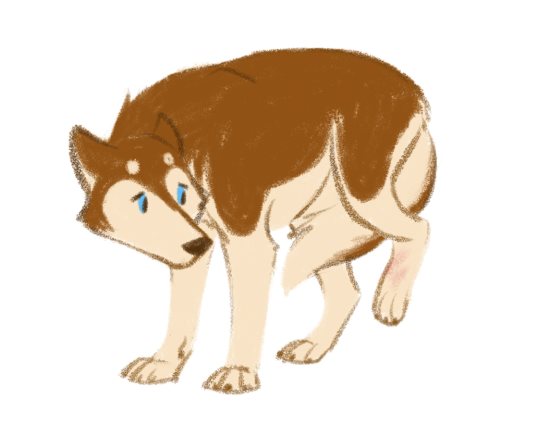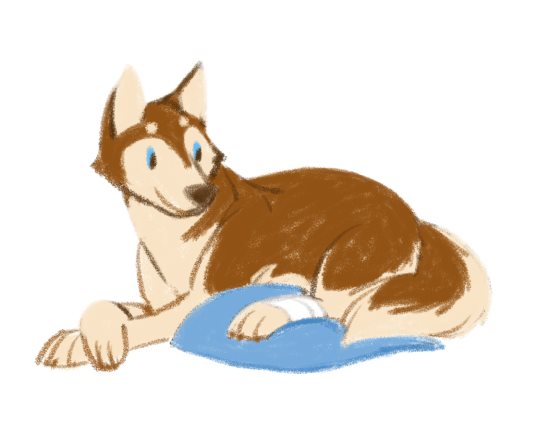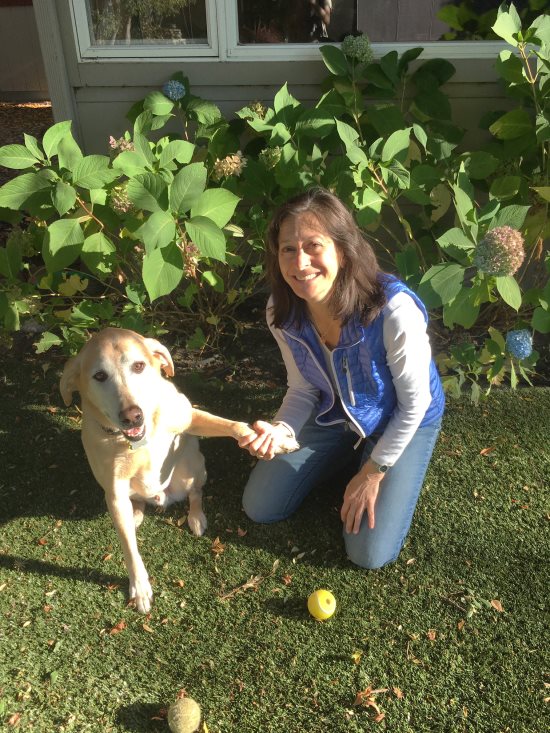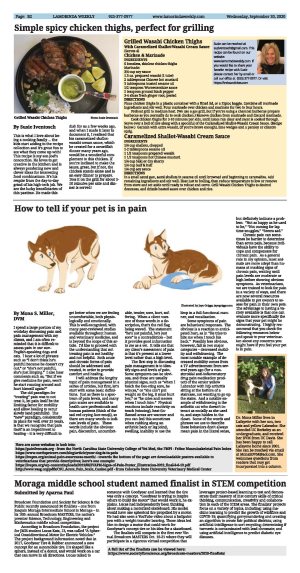| | Published September 30th, 2020
| How to tell if your pet is in pain
| | | By Mona S. Miller, DVM |  | | Illustrated by Jaya Griggs; www.jayagriggs.com |
I spend a large portion of my workday discussing pain and pain management with my clients, and I am often reminded that it is difficult to assess pain in our non-English-speaking dogs and cats. I hear a lot of phrases such as "I don't think he's painful because he doesn't cry out," or "she's not painful, she's just limping." I also hear comments such as, "But if we give medicine for pain, won't he start running around and hurt himself again?"
 The old paradigm for "treating" pain was to not treat it, let pain itself be the limiting factor for mobility and allow healing to occur slowly (and painfully). The "new" paradigm, consistently in place for well over 25 years, is that we recognize that pain itself is an impediment to healing - it is very difficult to get better when we are feeling uncomfortable, both physiologically and emotionally. This is well-recognized, with many peer-reviewed studies available throughout human and veterinary medicine, and is beyond the scope of this article. I'd like to proceed with the understanding that not treating pain is not healthy and not helpful. Both acute and chronic forms of pain should be addressed and treated, in order to provide comfort and healing.
The old paradigm for "treating" pain was to not treat it, let pain itself be the limiting factor for mobility and allow healing to occur slowly (and painfully). The "new" paradigm, consistently in place for well over 25 years, is that we recognize that pain itself is an impediment to healing - it is very difficult to get better when we are feeling uncomfortable, both physiologically and emotionally. This is well-recognized, with many peer-reviewed studies available throughout human and veterinary medicine, and is beyond the scope of this article. I'd like to proceed with the understanding that not treating pain is not healthy and not helpful. Both acute and chronic forms of pain should be addressed and treated, in order to provide comfort and healing.
 I will address the lengthy topic of pain management in a series of articles, but first, let's start with some basic definitions. Just as there is a spectrum of pain levels, and many pain scales are available to health care professionals and human patients (think of the sad red crying face emoji), so there are many words to indicate levels of pain. These words include the obvious: pain, discomfort, uncomfortable, tender, sore, hurt, suffering. When a client uses one of these words in a description, that's the red flag being waved. The statement "he's not painful, he's just sore" is a contradiction - but it provides good information to me as a vet. It tells me that my client's assessment of pain is that it's present at a lower level rather than a high level.
I will address the lengthy topic of pain management in a series of articles, but first, let's start with some basic definitions. Just as there is a spectrum of pain levels, and many pain scales are available to health care professionals and human patients (think of the sad red crying face emoji), so there are many words to indicate levels of pain. These words include the obvious: pain, discomfort, uncomfortable, tender, sore, hurt, suffering. When a client uses one of these words in a description, that's the red flag being waved. The statement "he's not painful, he's just sore" is a contradiction - but it provides good information to me as a vet. It tells me that my client's assessment of pain is that it's present at a lower level rather than a high level.
 The first step in discussing pain management is to identify signs and levels of pain. Some symptoms can be obvious, and these are usually physical signs, such as "when I touch the bee-sting sore, he winces," or "she can't put weight on the leg, it must hurt her," or "he cries and meows when I touch him." Physical reactions include reactivity on touch (wincing), heat (inflamed areas are warmer and you can feel this sometimes when rubbing along an arthritic back or leg joint), swelling, inability to use the limp in a full functional manner, and vocalization.
The first step in discussing pain management is to identify signs and levels of pain. Some symptoms can be obvious, and these are usually physical signs, such as "when I touch the bee-sting sore, he winces," or "she can't put weight on the leg, it must hurt her," or "he cries and meows when I touch him." Physical reactions include reactivity on touch (wincing), heat (inflamed areas are warmer and you can feel this sometimes when rubbing along an arthritic back or leg joint), swelling, inability to use the limp in a full functional manner, and vocalization.
 Some symptoms of pain are behavioral responses. The obvious is a reaction to anticipated hurt, as in "He tries to bite me when I touch his back." Possibly less obvious, however, fall in two major categories - decreased mobility and withdrawing. The most notable example of decreased mobility comes from a TV advertisement from several years ago (for a non-steroidal anti-inflammatory drug pain medication product) of the senior yellow Labrador with hip arthritis sitting at the bottom of a staircase, not wanting to go up the stairs. And a notable example of withdrawing is the arthritic cat who doesn't interact as socially as she used to, and stays hidden in the closet. Some of the words and phrases we use to describe these behaviors don't always mean pain in the literal sense, but definitely indicate a problem: "Not as happy as he used to be," "Not coming for lap time snuggles," "Seems sad."
Some symptoms of pain are behavioral responses. The obvious is a reaction to anticipated hurt, as in "He tries to bite me when I touch his back." Possibly less obvious, however, fall in two major categories - decreased mobility and withdrawing. The most notable example of decreased mobility comes from a TV advertisement from several years ago (for a non-steroidal anti-inflammatory drug pain medication product) of the senior yellow Labrador with hip arthritis sitting at the bottom of a staircase, not wanting to go up the stairs. And a notable example of withdrawing is the arthritic cat who doesn't interact as socially as she used to, and stays hidden in the closet. Some of the words and phrases we use to describe these behaviors don't always mean pain in the literal sense, but definitely indicate a problem: "Not as happy as he used to be," "Not coming for lap time snuggles," "Seems sad."
 Chronic pain can sometimes be harder to determine than acute pain, because individuals have the ability to cope and compensate for chronic pain. As a general rule in my opinion, most animals are more adept than humans at masking signs of chronic pain, waiting until pain levels are moderate or high before showing obvious symptoms. As veterinarians, we are trained to look for pain in a variety of ways, and there are now several resources available to pet owners to assess for pain in their own pets. The advantage to having a variety available is that one can evaluate more specifically the signs that your pet might be demonstrating. I highly recommend that you check the following resources below and speak to your veterinarian about any concerns you might have if you feel your pet is in pain.
Chronic pain can sometimes be harder to determine than acute pain, because individuals have the ability to cope and compensate for chronic pain. As a general rule in my opinion, most animals are more adept than humans at masking signs of chronic pain, waiting until pain levels are moderate or high before showing obvious symptoms. As veterinarians, we are trained to look for pain in a variety of ways, and there are now several resources available to pet owners to assess for pain in their own pets. The advantage to having a variety available is that one can evaluate more specifically the signs that your pet might be demonstrating. I highly recommend that you check the following resources below and speak to your veterinarian about any concerns you might have if you feel your pet is in pain.
 Here are some websites to look into:
Here are some websites to look into:
 https://painfreecats.org - from the North Carolina State University College of Vet Med, the FMPI - Feline Musculoskeletal Pain Index
https://painfreecats.org - from the North Carolina State University College of Vet Med, the FMPI - Feline Musculoskeletal Pain Index
 https://www.zoetispetcare.com/blog/article/your-dog-is-in-pain
https://www.zoetispetcare.com/blog/article/your-dog-is-in-pain
 https://ivapm.org/animal-pain-awareness-month/ - towards the bottom of the page are downloadable posters available to veterinarians that provide descriptives; here's one example:
https://ivapm.org/animal-pain-awareness-month/ - towards the bottom of the page are downloadable posters available to veterinarians that provide descriptives; here's one example:
 https://ivapm.org/wp-content/uploads/2019/08/IVAPM-Signs-of-Pain-Poster_Illustration-2019_final-8-6-19.pdf
https://ivapm.org/wp-content/uploads/2019/08/IVAPM-Signs-of-Pain-Poster_Illustration-2019_final-8-6-19.pdf
 http://www.vasg.org/pdfs/CSU_Acute_Pain_Scale_Canine.pdf - from Colorado State University Veterinary Medical Center
http://www.vasg.org/pdfs/CSU_Acute_Pain_Scale_Canine.pdf - from Colorado State University Veterinary Medical Center |
 | | Illustrated by Jaya Griggs; www.jayagriggs.com |  | | Dr. Mona Miller lives in Lafayette with her son, two cats and yellow Labrador. She attended UC Berkeley as an undergraduate, and received her DVM from UC Davis. She has been happy to call Lafayette home since 2001. She can be reached via email at MonaSDVM@aol.com. She welcomes questions from readers that may get incorporated into a column. | | | | | | | | | |





